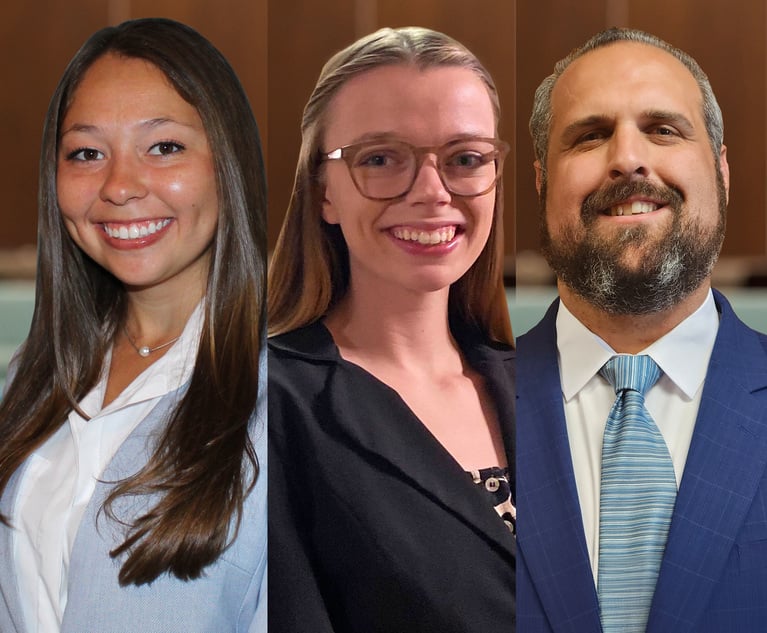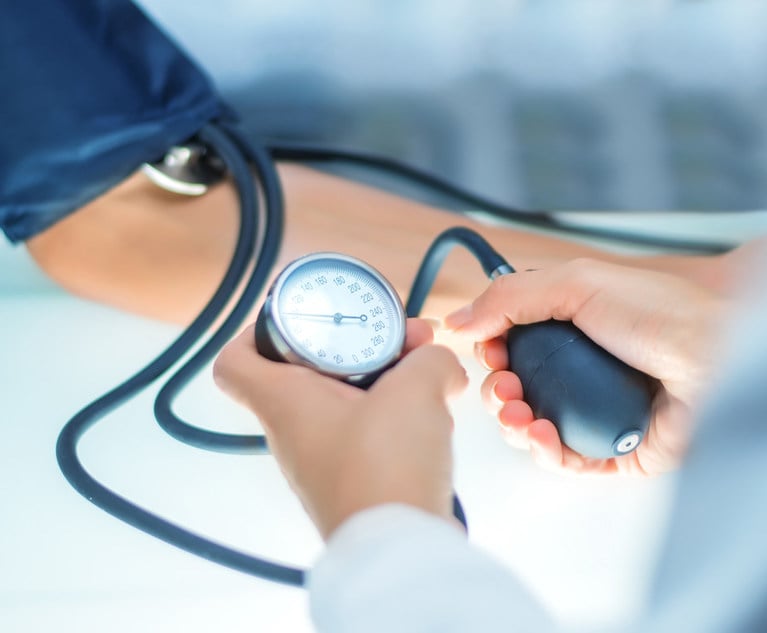New Jersey Has Limited Connection to the World of SCOTUS Clerks
The community of those who've served U.S. Supreme Court clerkships, and the "feeder" judges who shepherd them along, is a world unto itself, and is one with very defined, but also very limited, ties to New Jersey.
December 20, 2017 at 01:48 PM
4 minute read
 U.S. Supreme Court building in Washington, D.C.
U.S. Supreme Court building in Washington, D.C.
The community of those who've served U.S. Supreme Court clerkships, and the “feeder” judges effectively helping fill those ranks, is a world unto itself, and is one with very defined, but also very limited, ties to New Jersey.
That's one takeaway from a recent series of reports by sibling publication The National Law Journal, which examined clerk demographics during the Roberts court, from 2005 up to this year.
The research turned up just one former U.S. Supreme Court clerk practicing in New Jersey: Adam Ciongoli, who became general counsel of Camden-based Campbell Soup Co. in mid-2015. Ciongoli twice clerked for Samuel Alito—first, when Alito was a judge on the U.S. Court of Appeals for the Third Circuit, and then in 2005, after Alito had been elevated to the high court and after Ciongoli had practiced privately and in government roles.
The population of former clerks is higher in neighboring markets: NLJ located 54 former Supreme Court clerks practicing in New York, and five practicing in Pennsylvania.
As for feeding Supreme Court clerkship ranks, New Jersey's law schools account for two such clerks during the Roberts court, NLJ found. By comparison, Columbia Law School alone accounted for 24 graduates clerking for the court from 2005 to 2017, ranking sixth; University of Pennsylvania ranks No. 15, accounting for six graduate-clerks during that timeframe. Harvard and Yale law schools lead all others by degrees, with 124 and 119 graduate-clerks, respectively, according to the research.
Seton Hall University School of Law's lone graduate-clerk from 2005 to 2017 is Lucas Townsend, who clerked for Alito during the 2009 term, after clerking for Third Circuit Judge Maryanne Trump Barry. He currently is a litigation partner in Gibson, Dunn & Crutcher's Washington, D.C., office, handling appellate, constitutional and intellectual property law.
From Rutgers Law School—Camden came Claire Evans, a Westmont native who during the 2008 term clerked for Justice Clarence Thomas, whom NLJ credits with casting the widest net when it comes to taking on clerks. Evans—who had previously clerked for U.S. District Judge Jerome Simandle in Camden, in 2002-04, as well as for Judge David Sentelle of the D.C. Circuit—is now a litigation partner and chair of the appellate practice at Wiley Rein's Washington, D.C., office.
In an interview with NLJ, Evans offered the following advice for those looking to land a coveted high court clerkship: “To the extent that you're applying from a school that does not traditionally send folks to the court, it's important to stand out academically. There's no substitute for a good GPA.”
Perhaps Alito himself gives the Supreme Court its strongest New Jersey connection. Trenton-born, a graduate of Princeton University, and former U.S. attorney for the District of New Jersey, Alito was appointed to the Third Circuit bench in 1990. Following his elevation to the Supreme Court, Alito would come to hire nine of his former Third Circuit clerks to Supreme Court clerkships, according to the research.
The Third Circuit in its entirety is middle-of-the pack when it comes to feeding high court clerkships. Of the nearly 500 Supreme Court clerks during that timeframe, 18 had prior Third Circuit clerkships, placing that circuit seventh among 12. (That means half of those 18 were Alito's Third Circuit clerks whom he rehired).
Other Third Circuit judges sending clerks to the Roberts court are: Anthony Scirica (four); Michael Chagares (two); and Edward Becker, Thomas Ambro and Maryanne Trump Barry (one each).
With four former clerks moving on to the Supreme Court, Scirica ranks 29th among feeder judges. Three of those went on the clerk for Alito; the other, for Justice Ruth Bader Ginsburg.
Among NLJ's broader findings is the fact that Supreme Court clerks have been disproportionately male and white in comparison to law school graduate and law firm associate demographics.
This content has been archived. It is available through our partners, LexisNexis® and Bloomberg Law.
To view this content, please continue to their sites.
Not a Lexis Subscriber?
Subscribe Now
Not a Bloomberg Law Subscriber?
Subscribe Now
NOT FOR REPRINT
© 2025 ALM Global, LLC, All Rights Reserved. Request academic re-use from www.copyright.com. All other uses, submit a request to [email protected]. For more information visit Asset & Logo Licensing.
You Might Like
View All
On the Move and After Hours: Trenk Isabel; Connell Foley; Faegre Drinker; ABOTA Northern NJ Chapter
3 minute read

Lack of Available Auto Safety Features Does Not Equal Products Liability Act Violation, NJ Appeals Court Says
4 minute read
Trending Stories
- 1$2M Settlement for Woman Struck by New Jersey Transit Bus
- 2BREAKING: Donald Trump to Face Sentencing on January 10, Judge Rules
- 3Samuel M. Lehrer, Retired Philadelphia Court of Common Pleas Judge, Dies
- 4Buchanan Ingersoll Launches in Chicago With Locke Lord IP Team
- 5After $4M Verdict, Federal Judge Denies Request for New Trial on Unsuccessful Trademark Claims
Who Got The Work
Michael G. Bongiorno, Andrew Scott Dulberg and Elizabeth E. Driscoll from Wilmer Cutler Pickering Hale and Dorr have stepped in to represent Symbotic Inc., an A.I.-enabled technology platform that focuses on increasing supply chain efficiency, and other defendants in a pending shareholder derivative lawsuit. The case, filed Oct. 2 in Massachusetts District Court by the Brown Law Firm on behalf of Stephen Austen, accuses certain officers and directors of misleading investors in regard to Symbotic's potential for margin growth by failing to disclose that the company was not equipped to timely deploy its systems or manage expenses through project delays. The case, assigned to U.S. District Judge Nathaniel M. Gorton, is 1:24-cv-12522, Austen v. Cohen et al.
Who Got The Work
Edmund Polubinski and Marie Killmond of Davis Polk & Wardwell have entered appearances for data platform software development company MongoDB and other defendants in a pending shareholder derivative lawsuit. The action, filed Oct. 7 in New York Southern District Court by the Brown Law Firm, accuses the company's directors and/or officers of falsely expressing confidence in the company’s restructuring of its sales incentive plan and downplaying the severity of decreases in its upfront commitments. The case is 1:24-cv-07594, Roy v. Ittycheria et al.
Who Got The Work
Amy O. Bruchs and Kurt F. Ellison of Michael Best & Friedrich have entered appearances for Epic Systems Corp. in a pending employment discrimination lawsuit. The suit was filed Sept. 7 in Wisconsin Western District Court by Levine Eisberner LLC and Siri & Glimstad on behalf of a project manager who claims that he was wrongfully terminated after applying for a religious exemption to the defendant's COVID-19 vaccine mandate. The case, assigned to U.S. Magistrate Judge Anita Marie Boor, is 3:24-cv-00630, Secker, Nathan v. Epic Systems Corporation.
Who Got The Work
David X. Sullivan, Thomas J. Finn and Gregory A. Hall from McCarter & English have entered appearances for Sunrun Installation Services in a pending civil rights lawsuit. The complaint was filed Sept. 4 in Connecticut District Court by attorney Robert M. Berke on behalf of former employee George Edward Steins, who was arrested and charged with employing an unregistered home improvement salesperson. The complaint alleges that had Sunrun informed the Connecticut Department of Consumer Protection that the plaintiff's employment had ended in 2017 and that he no longer held Sunrun's home improvement contractor license, he would not have been hit with charges, which were dismissed in May 2024. The case, assigned to U.S. District Judge Jeffrey A. Meyer, is 3:24-cv-01423, Steins v. Sunrun, Inc. et al.
Who Got The Work
Greenberg Traurig shareholder Joshua L. Raskin has entered an appearance for boohoo.com UK Ltd. in a pending patent infringement lawsuit. The suit, filed Sept. 3 in Texas Eastern District Court by Rozier Hardt McDonough on behalf of Alto Dynamics, asserts five patents related to an online shopping platform. The case, assigned to U.S. District Judge Rodney Gilstrap, is 2:24-cv-00719, Alto Dynamics, LLC v. boohoo.com UK Limited.
Featured Firms
Law Offices of Gary Martin Hays & Associates, P.C.
(470) 294-1674
Law Offices of Mark E. Salomone
(857) 444-6468
Smith & Hassler
(713) 739-1250






